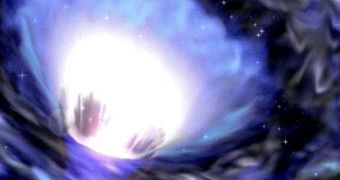Stephen Hawking is renowned around the world as one of the brightest minds of our times, and he owes part of this fame to the theory predicting the existence of radiation now bearing his name. A team of experts recently put his calculations to the test.
What Hawking proposes is that black holes produce a form of weak radiation, that could be detected if only we knew what to look for. When he first published his theory, the accompanying calculations were analyzed on all sides by peers and other theoretical physicists.
Black holes are the collapsed remnants of massive stars, which imploded under their own weight when their precursor star went supernova. The resulting core is so dense that it exerts a massive gravitational pull on everything in its area of influence.
This pull is so intense that scientists believe not even light can escape. But Hawking proposed that, as light enters a black hole never to come out again, pairs of photons – the elementary particles that make up light – are broken apart.
Due to a complex series of physical processes, one of the photons in each pair gets absorbed in the black hole, whereas the other gets rejected, and therefore emitted as a weak form of radiation.
This theory was proposed more than 35 years ago, and no research group has thus far been able to demonstrate that it's true. Still, the theoretical emissions were named Hawking radiation.
Recently, physicists at the University of British Columbia, in Canada, decided to test whether the radiation can actually exist. Since it's impossible to create a black hole, they turned to its temporal counterpart, a white hole.
They simulated such a construct in a six-meter-long flume of flowing water, in which they placed a airplane wing-shaped obstacle. The flow disturbances and interferences that were produced as water rushed in to fill the void behind the obstacle act as the equivalent of a white hole.
International postdoctoral researcher Silke Weinfurtner led the UBC team, which published the results of its discovery in the latest issue of the top scientific journal Physical Review Letters.
Just like Hawking's theory proposed, shallower surface waves divided into pairs of deep-water waves (the equivalent of photon pairs) for a black hole. Those waves emitted a thermal spectrum of radiation.
“While this creative simulation obviously doesn't prove Hawking's theory, it does show that his ideas apply broadly,” explains team member William Unruh, a theoretical physicist at UBC, quoted by SpaceRef.
“Irrespective of their potential relevance to Hawking's theory, the experiments have raised a number of unanswered fluids mechanics questions of engineering interest,” adds the Canada Research Chair in Environmental Fluid Mechanics at the university, Gregory Lawrence.
“This experiment also exemplifies all of the strengths of UBC's research enterprise – the involvement of students, our international outreach and connections, and a very open, collaborative way of looking at scientific questions,” Unruh concludes.

 14 DAY TRIAL //
14 DAY TRIAL //